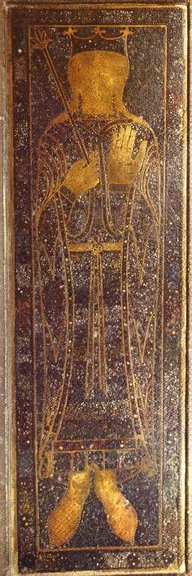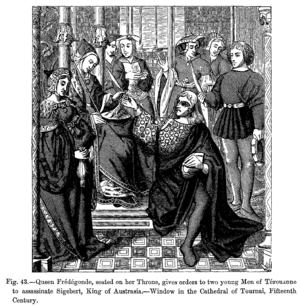Fredegund facts for kids
Quick facts for kids Fredegund |
|
|---|---|
| Queen consort of Neustria (Soissons) | |

Fredegund as depicted in her funerary effigy at the Basilica of Saint-Denis
|
|
| Born | Unknown |
| Died | 597 Paris |
| Burial | Saint Denis Basilica, Paris |
| Spouse | Chilperic I |
| Issue | Samson Rigunth Chlothar II |
Fredegund (also spelled Fredegunda) was a powerful queen in the Frankish kingdom of Neustria. She was the wife of Chilperic I, a Merovingian king. After Chilperic's death, she became the ruler for her young son, Chlothar II, from 584 until her own death in 597.
Fredegund is often described in history books as a very strong and sometimes harsh queen. Much of what we know about her comes from the writings of Gregory of Tours, a bishop who lived at the same time.
Contents
Becoming Queen of Neustria
Fredegund came from a humble family. She started as a servant to King Chilperic's first wife, Audovera. Fredegund became close to King Chilperic. She convinced him to end his marriage with Audovera.
Later, King Chilperic married Galswintha. This marriage brought a large dowry, which was a gift of money or property. However, Galswintha died soon after. Fredegund then became queen. Galswintha's sister, Brunhilda, was very upset by this. She started a long-lasting rivalry with Fredegund that continued for over 40 years.
In 580 AD, a serious illness spread across Gaul. King Chilperic and two of Fredegund's sons, Chlodobert and Dagobert, became sick. Fredegund believed her actions might have caused the illness. She destroyed some tax records she thought were unfair. Sadly, her sons did not survive the sickness. After their funerals, Fredegund gave a lot of money to churches and people in need.
Another of Fredegund's sons, Samson, also became very ill. Fredegund was worried about catching the disease. She initially kept her distance from him. The King was concerned because Samson had not yet been baptized. When Samson showed signs of recovery, Fredegund agreed to have him baptized as the King wished.
Challenges with Daughter Rigunth
Gregory of Tours wrote about the difficult relationship between Fredegund and her daughter, Rigunth.
When Rigunth was sent to Spain to marry Prince Reccared, a Visigothic prince, her group carried many valuable gifts. Some Frankish nobles complained that the royal treasury was running low because of all the gifts. Fredegund insisted that all the gifts came from her husband's generosity. During the long trip, Rigunth's helpers often stole from her and left her. By the time she reached Toulouse, there was little left.
Leading the Kingdom as Regent
After King Chilperic I died in 584, Fredegund became the regent for her very young son, Chlothar II. A regent is someone who rules a kingdom when the true king or queen is too young. She found safety in the cathedral of Paris. With the help of King Guntram, she made sure her son Chlothar was recognized as the new king of Neustria.
During the later part of her life, there was a lot of fighting between Neustria and the kingdoms of Austrasia and Burgundy. Fredegund took on a leadership role in these wars. She often led the Neustrian armies to victory.
Fredegund's Religious Support
During her time as regent, Fredegund kept the support of the church leaders. Historians have found that many bishops in Northern Gaul remained loyal to Fredegund and her son Chlothar. Fredegund also gave money to church leaders. For example, Bishop Bertram of Le Mans received land as a gift from Fredegund and Chlothar II. The Neustrian monarchy also had good relationships with and supported St. Radegund’s monastery in Poitiers.
Major Conflicts and Plots
Fredegund is believed to have ordered the killing of Sigebert I of Austrasia in 575. She also tried to harm Sigebert's son, Childebert II, her brother-in-law Guntram, and Brunhild. After Chilperic's mysterious death in 584, Fredegund took the King's wealth. She found safety in the Notre Dame de Paris cathedral. Both she and her son, Clothar II, were protected by King Guntram until he died in 592. In 593, she led her troops to a surprising victory against Brunhilda's troops at the Battle of Droizy.
Trouble with Bishop Praetextatus
Gregory of Tours also suggests that Fredegund was behind the persecution of Bishop Praetextatus. After Praetextatus returned from being sent away, the Queen met him in church. She threatened to have him sent away again. However, the Bishop was not afraid. He believed he would be rewarded in heaven, while Fredegund would face punishment. In 586, Fredegund reportedly ordered Praetextatus's killing. One of her agents stabbed him during a church service. The Queen later visited Praetextatus as he was dying. She offered help from her doctors. Gregory of Tours thought this was an excuse to watch him die. Praetextatus urged her to change her ways before he passed away.
Death and Legacy
Fredegund died peacefully on December 8, 597, in Paris. Her tomb, made of marble and copper, is located in the Saint Denis Basilica.
Fredegund did not live to see it, but the later execution of Brunhilda by her son, Chlothar II, showed the lasting impact of the conflict between the two queens.
Fredegund's Historical Reputation
Fredegund has traditionally had a negative reputation in history. According to Gregory of Tours, she was involved in many plots and was responsible for the deaths of political figures and church leaders. However, Gregory of Tours' writings might be biased against Fredegund.
Historians note that there are some strange details in Gregory's accounts. For example, Bishop Leudovald, whom Fredegund supposedly tried to harm, later helped her. He even freed one of her messengers who was accused of carrying out a plot for her. Also, during the reign of Fredegund’s son, King Chlothar II, Leudovald continued to receive favors from the Neustrian monarchy. He was even invited to an important meeting in 614.
These inconsistencies suggest that Gregory's portrayal of Fredegund might be exaggerated. This exaggeration could be due to his connections outside of Neustria. Gregory was a Gallo-Roman bishop with ties to King Sigebert and his wife Brunhild, who were rivals of Neustria. Gregory likely wanted to support Brunhild, so he showed Fredegund in a very bad light. He accused Fredegund of witchcraft and treason, while almost never criticizing Brunhild.
Later writers, like Fredegar, gave different accounts of Brunhild. After Gregory's death, Brunhild lost power. She was accused of many killings and faced a harsh death. These accusations show that Brunhild also had enemies, just like Fredegund. The main difference was that Brunhild had Gregory, who wrote in her favor.
Cultural Impact
French composers in the late Romantic period created music based on Fredegund's story. Ernest Guiraud started an opera called Frédégonde. He died before finishing it in 1892. It was then completed by Camille Saint-Saëns and Paul Dukas. It first played in 1895. Another composer, Max d'Ollone, won an award in 1897 for his cantata (a type of musical piece) called Frédégonde.
Images for kids
See also
 In Spanish: Fredegunda para niños
In Spanish: Fredegunda para niños


